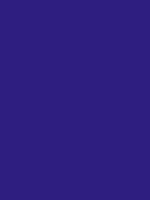#2d1d7d Color Information
In a RGB color space, hex #2d1d7d is composed of 17.6% red, 11.4% green and 49% blue. Whereas in a CMYK color space, it is composed of 64% cyan, 76.8% magenta, 0% yellow and 51% black. It has a hue angle of 250 degrees, a saturation of 62.3% and a lightness of 30.2%. #2d1d7d color hex could be obtained by blending #5a3afa with #000000. Closest websafe color is: #333366.
-
- R 18
- G 11
- B 49
-
- C 64
- M 77
- Y 0
- K 51
● #2d1d7d color description : Dark blue.
#2d1d7d Color Conversion
The hexadecimal color #2d1d7d has RGB values of R:45, G:29, B:125 and CMYK values of C:0.64, M:0.77, Y:0, K:0.51. Its decimal value is 2956669.
| Hex triplet | 2d1d7d | #2d1d7d |
|---|---|---|
| RGB Decimal | 45, 29, 125 | rgb(45,29,125) |
| RGB Percent | 17.6, 11.4, 49 | rgb(17.6%,11.4%,49%) |
| CMYK | 64, 77, 0, 51 | |
| HSL | 250°, 62.3, 30.2 | hsl(250,62.3%,30.2%) |
| HSV (or HSB) | 250°, 76.8, 49 | |
| Web Safe | 333366 | #333366 |
| CIE-LAB | 19.709, 36.169, -51.53 |
|---|---|
| XYZ | 5.223, 2.917, 19.689 |
| xyY | 0.188, 0.105, 2.917 |
| CIE-LCH | 19.709, 62.957, 305.065 |
| CIE-LUV | 19.709, -1.151, -57.737 |
| Hunter-Lab | 17.079, 24.692, -56.392 |
| Binary | 00101101, 00011101, 01111101 |
Color Schemes with #2d1d7d
Alternatives to #2d1d7d
Below, you can see some colors close to #2d1d7d. Having a set of related colors can be useful if you need an inspirational alternative to your original color choice.
#2d1d7d Preview
This text has a font color of #2d1d7d.
<span style="color:#2d1d7d;">Text here</span>This paragraph has a background color of #2d1d7d.
<p style="background-color:#2d1d7d;">Content here</p>This element has a border color of #2d1d7d.
<div style="border:1px solid #2d1d7d;">Content here</div>.text {color:#2d1d7d;}.background {background-color:#2d1d7d;}.border {border:1px solid #2d1d7d;}Shades and Tints of #2d1d7d
A shade is achieved by adding black to any pure hue, while a tint is created by mixing white to any pure color. In this example, #05030e is the darkest color, while #fdfdfe is the lightest one.
-
#05030e
#05030ergb(5,3,14) -
#0b071d
#0b071drgb(11,7,29) -
#100b2d
#100b2drgb(16,11,45) -
#160e3d
#160e3drgb(22,14,61) -
#1c124d
#1c124drgb(28,18,77) -
#22165d
#22165drgb(34,22,93) -
#27196d
#27196drgb(39,25,109) -
#2d1d7d
#2d1d7drgb(45,29,125) -
#33218d
#33218drgb(51,33,141) -
#38249d
#38249drgb(56,36,157) -
#3e28ad
#3e28adrgb(62,40,173) -
#442cbd
#442cbdrgb(68,44,189) -
#4a2fcd
#4a2fcdrgb(74,47,205)
-
#563ed2
#563ed2rgb(86,62,210) -
#644dd6
#644dd6rgb(100,77,214) -
#725dda
#725ddargb(114,93,218) -
#806ddd
#806dddrgb(128,109,221) -
#8e7de1
#8e7de1rgb(142,125,225) -
#9c8de5
#9c8de5rgb(156,141,229) -
#aa9de8
#aa9de8rgb(170,157,232) -
#b8adec
#b8adecrgb(184,173,236) -
#c5bdf0
#c5bdf0rgb(197,189,240) -
#d3cdf3
#d3cdf3rgb(211,205,243) -
#e1ddf7
#e1ddf7rgb(225,221,247) -
#efedfb
#efedfbrgb(239,237,251) -
#fdfdfe
#fdfdfergb(253,253,254)
Tones of #2d1d7d
A tone is produced by adding gray to any pure hue. In this case, #4d4c4e is the less saturated color, while #1d0595 is the most saturated one.
-
#4d4c4e
#4d4c4ergb(77,76,78) -
#494654
#494654rgb(73,70,84) -
#454159
#454159rgb(69,65,89) -
#413b5f
#413b5frgb(65,59,95) -
#3d3565
#3d3565rgb(61,53,101) -
#392f6b
#392f6brgb(57,47,107) -
#352971
#352971rgb(53,41,113) -
#312377
#312377rgb(49,35,119) -
#2d1d7d
#2d1d7drgb(45,29,125) -
#291783
#291783rgb(41,23,131) -
#251189
#251189rgb(37,17,137) -
#210b8f
#210b8frgb(33,11,143) -
#1d0595
#1d0595rgb(29,5,149)
Color Blindness Simulator
Below, you can see how #2d1d7d is perceived by people affected by a color vision deficiency. This can be useful if you need to ensure your color combinations are accessible to color-blind users.
